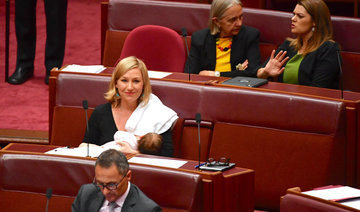SYDNEY: Australian anti-immigration politician Pauline Hanson caused a furor Thursday when she entered the Senate wearing a full burqa, earning a blistering rebuke from the country’s top lawyer for the “appalling” stunt.
Hanson wore the garment in the chamber to highlight what she said were the security issues it posed, linking it to terrorism as fellow senators heckled her.
“Will you work to ban the burqa in Australia in light of what is happening with national security?” she said after whipping off the garment to question Attorney-General George Brandis.
She added: “Terrorism is a true threat to our country, many Australians are in fear of it.”
Brandis said his conservative government had no such plans, warning Hanson she risked offending the Muslim community by wearing a burka when she was not a follower of Islam.
“To ridicule that community, to drive it into a corner, to mock its religious garments is an appalling thing to do, and I would ask you to reflect on what you have done,” he said.
Brandis, his voice cracking with emotion, also said that being a strict adherent Muslim, such as those who wear the burka, was “absolutely consistent” with being a law-abiding citizen.
“We have about half-a-million Australians in this country of the Islamic faith and the vast majority of them are law-abiding, good Australians,” he said.
Brandis’ remarks prompted a standing ovation from his political opponents in the Labor and Greens parties.
Independent Sen. Derryn Hinch labelled Hanson’s conduct “disgusting.”
“Pauline Hanson mocked the religion of some Australians ... she made a mockery of an honorable place (the Senate),” he told Sky News.
Labor senator Sam Dastyari accused Hanson of stoking extremism in a poorly timed bid for “a cheap headline.”
“In the same week that we saw white nationalism rear its ugly head in the country of our closest ally — in that week a stunt like this gets pulled in the Australian Senate,” he said.
“It is hurtful, it is offensive, it is wrong,“
Hanson first gained prominence in the 1990s, when she warned Australia was in danger of being “swamped by Asians.”
After a 12-year hiatus from politics she returned in 2014, this time targeting Muslims and was elected to the Senate two years later as leader of the right-wing One Nation party.
In her first speech after returning to parliament, she said Islam was “a culture and ideology that is incompatible with our own.”
Hanson was unrepentant after her latest stunt, telling commercial radio: “Is it extreme? Yes. Is it getting my message across? I hope so.”
Politician rebuked for wearing burqa in Australian Senate
Politician rebuked for wearing burqa in Australian Senate

Pakistan’s deputy PM says country seeks to convert $1 billion UAE deposit into investment

- Ishaq Dar says the UAE will acquire shares in Pakistani companies using the amount, with transaction to be completed by March 31
- The UAE’s remaining $2 billion in deposits, part of funds used to shore up Pakistan’s foreign reserves, are due for rollover in January
ISLAMABAD: Pakistan is seeking to convert part of its financial support from the United Arab Emirates into long-term investment to reduce external debt, Deputy Prime Minister Ishaq Dar said on Saturday, following talks with UAE President Sheikh Mohamed bin Zayed Al Nahyan during his visit to Islamabad.
Dar said Pakistan was engaged with the UAE on converting $1 billion in deposits into equity investment, potentially involving stakes in companies linked to the Fauji Fertilizer Group, a move that would end Pakistan’s repayment obligation on that portion of the funds.
The UAE has been one of Pakistan’s key financial backers in recent years, providing $3 billion in deposits to the central bank as part of a broader effort to stabilize the country’s external finances and unlock support from the International Monetary Fund.
Speaking at a year-end briefing, Dar said Pakistan had already begun discussions with the UAE on rolling over the first $1 billion tranche, but Islamabad now wanted to replace short-term borrowing with investment.
“They will be acquiring some shares, and this liability will end,” Dar said, adding that discussions were under way for the transaction to be completed by March 31.
Dar said the Fauji Foundation Group was taking the lead in the process, with plans for partial disinvestment by Fauji-linked and other companies to facilitate the deal.
He added that Pakistan also raised the issue of a separate $2 billion rollover due in January during talks with the UAE leadership, saying Islamabad had conveyed that converting debt into investment would be preferable to repeated rollovers.
The issue was discussed during Al Nahyan’s visit, which Dar described as cordial, adding that the UAE had expressed willingness to expand its investment footprint in Pakistan.
Pakistan has relied on repeated rollovers of deposits from friendly countries to manage its balance-of-payments pressures, a practice economists say provides short-term relief but adds to debt vulnerabilities unless replaced with foreign direct investment.
The country acquired $5 billion from Saudi Arabia and $4 billion from China, which, along with the UAE, helped shore up its foreign reserves and meet IMF conditions at a time when its external account was under severe pressure.
Dar said Pakistan was now focused on shifting from temporary financing toward longer-term capital inflows to stabilize its economy and reduce reliance on external borrowing.











